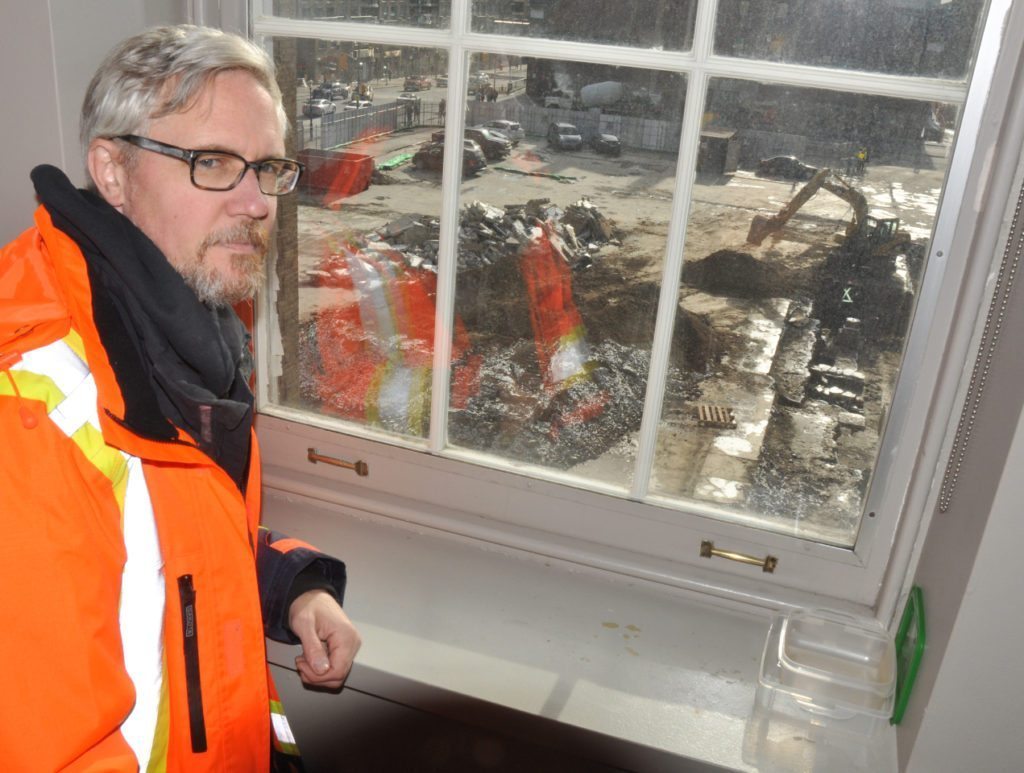Archaeological work at the demolished North St Lawrence Market shows cleanliness was very much the order of the day for its vendors. It had to be, with all the food they handled.

Archaeologist Peter Popkin looks over market work from the St. Lawrence Hall.
“It’s not as artifact rich. Really, it’s not as dirty as some of the domestic sites that we would find,” Peter Popkin, senior archaeologist with Golder Associates, said in an interview.
Popkin is manager of the archaeological side of the north market’s rejuvenation.
Archaeologists are digging down about 6 feet. The stone and brick market, built in 1831, had a significant sewer system, says Popkin, with a large north-south channel in the centre and small, stone feeder drains coming in from the east and west.
Artifacts his team are finding include knives, ceramics and butchers’ hooks. “It very much is the story of the daily life of the market,” said Popkin.
“There were regulations about keeping it clean and tidy.”
Householders in the market’s days weren’t that fussy where they dumped their refuse. “People would just dump all of their garbage in their backyard, dig a little pit for it or something like that, whereas that was not happening at the market,” said Popkin.
So how did the market and its vendors get rid of their garbage? Here’s where down-to-earth entrepreneurship played a role. Just like today’s garbage-pickers, who search through private garbage cans for liquor bottles and beer cans to return, the market had its own pickers.
“There would have been rag and bone men and other people who would have come and recycled a bunch of stuff,” said Popkin.
It’s possible, too, said Popkin that at the end of the market’s life stuff that vendors no longer wanted would have been dumped in the cellars that ran along the east and west side of the 1831 market.
“That’s a very good opportunity for people to get rid of a whole bunch of stuff, equipment they don’t need anymore,” said Popkin.
Before the 1831 market—the one just demolished was built in 1968—there was a market built of wood in 1820. There’s research into whether there might have been an even earlier wood building around 1814.
The St Lawrence Market’s site was decided by Lt. Gov. Peter Hunter in 1803. Back then there wouldn’t have been a building, just farmers with their stalls and carts in the open air.
Artifacts will be taken to a lab for washing. After that, they’re organized, counted and catalogued. Eventually, each item will be inspected to determine “a decent date range for when it was produced and when it was used,” said Popkin.
“We try to build up a picture of how things were being used and how things changed across time on this site.” A report will go to the city’s Preservation Services and Ontario’s culture ministry about the artifacts. Ultimately they’ll be handed over to the city to act as their guardian.
A current exhibition outlining the archaeological work is on display at the St Lawrence Market Gallery, running into the New Year.
—Dennis Hanagan
 TheBulletin.ca Journal of Downtown Toronto
TheBulletin.ca Journal of Downtown Toronto

